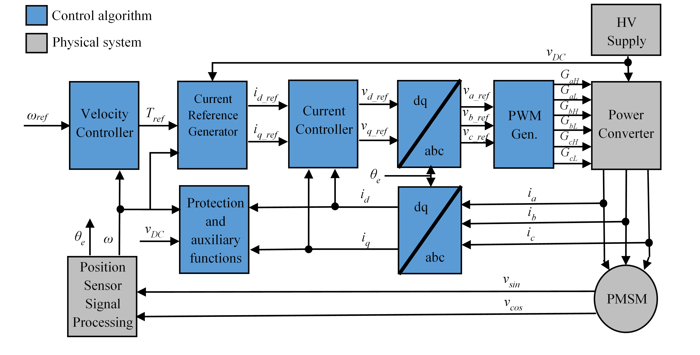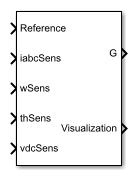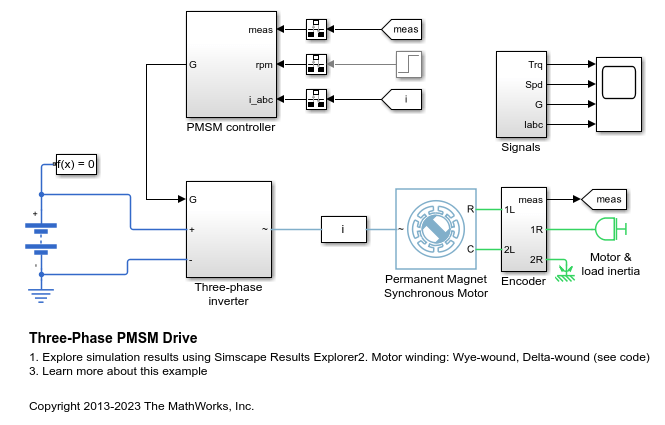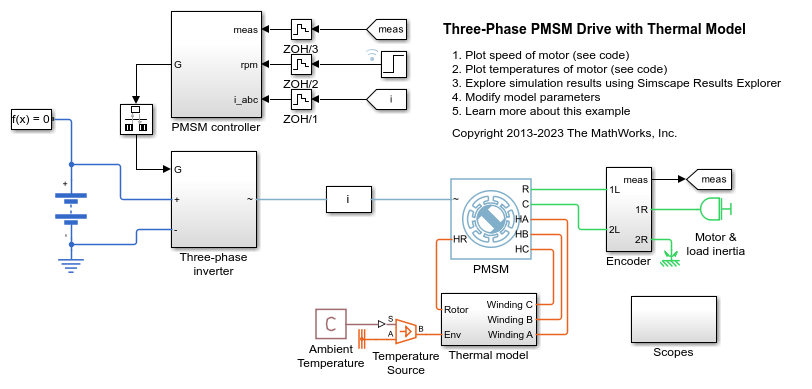PMSM Field-Oriented Control
Permanent magnet synchronous machine field-oriented control
Libraries:
Simscape /
Electrical /
Control /
PMSM Control
Description
The PMSM Field-Oriented Control block implements a field-oriented control structure for a permanent magnet synchronous machine (PMSM). Field Oriented Control (FOC) is a performant AC motor control strategy that decouples torque and flux by transforming the stationary phase currents to a rotating frame. Use FOC when rotor speed and position are known and your application requires:
High torque and low current at startup.
High efficiency.
Equations
The PMSM FOC structure decouples the torque and flux by using the rotor d-q reference frame. This diagram shows the overall architecture of the block.

In the diagram:
ω and ωref are the measured and reference angular velocities, respectively.
Tref is the reference electromagnetic torque.
i and v are stator currents and voltages and subscripts d and q represent the d-axis and q-axis, and subscripts a, b, and c, represent the three stator windings.
θe is the rotor electrical angle.
G is a gate pulse, subscripts H and L, represent high and low, and subscripts a, b, and c represent the three stator windings.
You can choose to implement either velocity or torque control with
the Control mode parameter. The block implements velocity
control exactly as shown in the diagram. The block implements torque control by
removing the Velocity Controller block and accepting the reference torque
directly.
Assumptions
The machine parameters are known.
Limitations
The control structure is implemented with a single sample rate.
Examples
Ports
Input
Output
Parameters
References
[1] Bernardes, T., V. F. Montagner, H. A. Gründling, and H. Pinheiro. "Discrete-time sliding mode observer for sensorless vector control of permanent magnet synchronous machine." IEEE Transactions on Industrial Electronics. Vol. 61, Number 4, 2014, pp. 1679–1691.
[2] Carpiuc, S., and C. Lazar. "Fast real-time constrained predictive current control in permanent magnet synchronous machine-based automotive traction drives." IEEE Transactions on Transportation Electrification. Vol.1, Number 4, 2015, pp. 326–335.
[3] Haque, M. E., L. Zhong, and M. F. Rahman. "Improved trajectory control for an interior permanent magnet synchronous motor drive with extended operating limit." Journal of Electrical & Electronics Engineering. Vol. 22, Number 1, 2003, p. 49.
[4] Yang, N., G. Luo, W. Liu, and K. Wang. "Interior permanent magnet synchronous motor control for electric vehicle using look-up table." In 7th International Power Electronics and Motion Control Conference. Vol. 2, 2012, pp. 1015–1019.
Extended Capabilities
Version History
Introduced in R2017b



